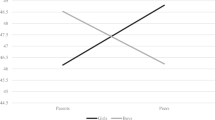Abstract
As part of a larger longitudinal study of psychosocial development, 148 girls and 130 boys were administered a series of questions regarding a close friend during their eighth-grade school year. Scales corresponding to shared experience, self-disclosure, and intimacy (defined as emotional closeness) were developed from these items. Path-analytic models tested the relative strength of the self-disclosure and shared experience paths to emotional closeness for boys and girls separately. The results indicated that the self-disclosure path to emotional closeness is significant for both boys and girls. No relationship was found between shared experience and emotional closeness in girls when controlling for self-disclosure. The relationship between shared experience and feelings of closeness was, however, significant for boys even while controlling for the effects of self-disclosure. Covariance structure analysis (LISREL) indicated that the covariance matrices for the three scales were significantly different for boys and girls. The results are considered in relation to the gender socialization and friendship literature. The potential importance of defining intimacy as emotional closeness is also discussed.
Similar content being viewed by others
References
Altman, I., and Taylor, D. A. (1973).Social Penetration: The Development of Interpersonal Relationships, Holt, Rinehart & Winston, New York.
Baltes, P. B. (1968). Longitudinal and cross-sectional sequences in the study of age and generation effects.Hum. Dev. 11: 145–171.
Berndt, T. (1982). The features and effects of friendship in early adolescence.Child Dev. 53: 1447–1460.
Blyth, D., Hill, J. P., and Thiel, K. S. (1982). Early adolescents' significant others: Grade and gender differences in perceived relationships with familial and nonfamilial adults and young people.J. Youth Adoles. 11: 425–450.
Brain, R. (1976).Friends and Lovers, Basic Books, New York.
Crockett, L., Losoff, M., and Petersen, A. C. (1984). Perceptions of the peer group and friendship in early adolescence.J. Early Adoles. 4: 155–181.
Diaz, R. M., and Berndt, T. J. (1982). Children's knowledge of a best friend: Fact or fancy?Dev. Psychol. 18: 787–794.
Douvan, E., and Adelson, J. (1966).The Adolescent Experience, Wiley, New York.
Fasteau, M. F. (1974).The Male Machine, McGraw-Hill, New York.
Fischer, J. L., and Narus, L. R. (1981). Sex roles and intimacy in same sex relationships.Psychol. Women Quart. 5: 164–169.
Hoelter, J. W. (1983). The analysis of covariance structures: Goodness-of-fit indices.Sociol. Meth. Res. 11: 325–344.
Hunter, F. T., and Youniss, J. (1982). Changes in functions of three relations during adolescence.Dev. Psychol. 18: 806–811.
Huston, T. L., and Levinger, G. (1978). Interpersonal attraction and relationships.Ann. Rev. Psychol. 29: 115–156.
Hinde, R. A. (1981). The bases of a science of interpersonal relationships. In Duck, S., and Gilmour, R. (eds.),Personal Relationships 1: Studying Personal Relationships, Academic Press, New York.
Kelley, H. H., Berscheid, E., Christensen, A., Harvey, J. H., Huston, T. L., Levinger, G., McClintock, E., Peplau, L. A., and Petersen, D. R. (1983). Analyzing close relationships. In Kelley, H. H. (ed.),Close Relationships, W. H. Freeman, New York.
Kelley, J. R. (1983).Leisure, Identity, and Interactions, George Allen & Unwin, London.
Lever, J. (1976). Sex differences in the games children play.Soc. Probl. 23: 478–487.
Mitchell, J. J. (1976). Adolescent intimacy.Adolescence 11: 275–280.
Petersen, A. C. (1984). The early adolescence study: An overview.J. Early Adoles. 4: 103–106.
Richards, M. H., Boxer, A. M., Petersen, A. C., and Albrecht, R. (1990). Relation of weight to body image in pubertal girls and boys from two communities.Dev. Psychol. 26: 313–321.
Richey, M. H., and Richey, H. W. (1980). The significance of best friend relationships in adolescence.Psychol. Schools 17: 536–540.
Schaie, K. W. (1965). A general model for the study of developmental problems.Psychol. Bull. 64: 92–107.
Sharabany, R., Gershoni, R., and Hofman, J. E. (1981). Girlfriend, boyfriend: Age and sex differences in intimate friendships.Dev. Psychol. 17: 800–808.
Sullivan, H. S. (1953).The Interpersonal Theory of Psychiatry, W. W. Norton, New York.
Author information
Authors and Affiliations
Additional information
The research reported here was supported by National Institute of Mental Health Grant MH30252/38142 to Anne C. Petersen.
Research interests include the development of the self-sytem and close relationships during adolescence and young adulthood.
Research interests include adolescent mental health and parent and peer relationships.
Received Ph.D. from the University of Chicago in 1973. Research interest is biopsychosocial development in adolescence, with a focus on sex differences in mental health.
Rights and permissions
About this article
Cite this article
Camarena, P.M., Sarigiani, P.A. & Petersen, A.C. Gender-specific pathways to intimacy in early adolescence. J Youth Adolescence 19, 19–32 (1990). https://doi.org/10.1007/BF01539442
Received:
Accepted:
Issue Date:
DOI: https://doi.org/10.1007/BF01539442




